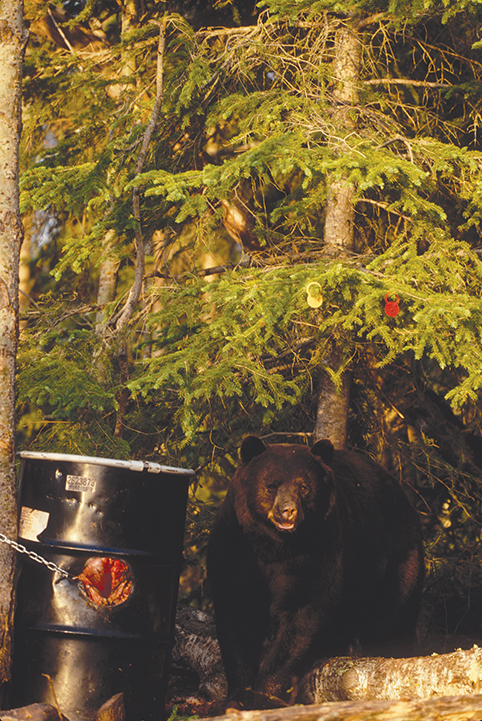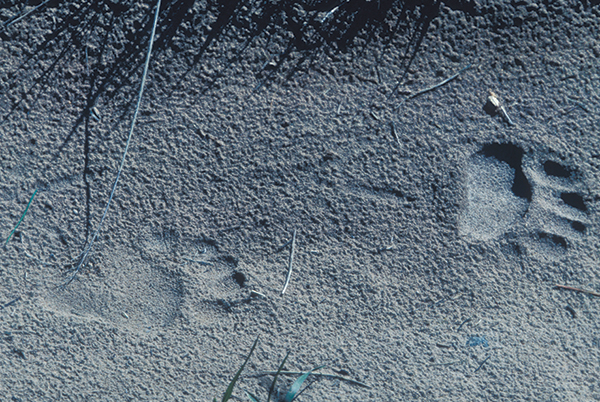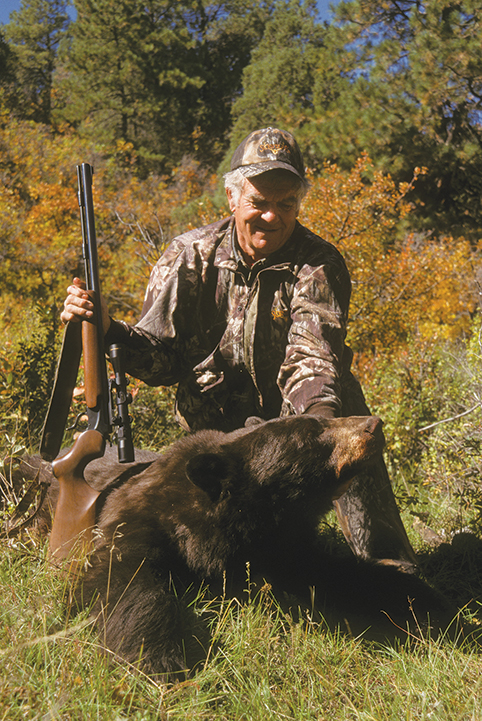 Hunting: Spring Bear Hunting
Hunting: Spring Bear Hunting
By Judd Cooney

The big black bear was unaware of my presence as I slid into shooting position over a small hummock in the salt-grass flat. About the same time I realized this bear was really big, I also noticed there was maybe 100 yards of grass flat between us, a distance a bear of that size could cover faster than a race horse. If my adrenalin wasn’t peaking before that last thought, it sure was after.
My partner and I had glassed the bear from the boat, feeding on the far side of a bay about a half-mile away. Then we had motored slowly along the shoreline until we were out of direct line of sight. We beached the boat, and I stalked 400 yards closer for that better look.
Over the last couple of weeks I’d glassed half a dozen black bears. Two were mature males but not quite what I wanted. I was in no rush. At the time I worked for the Alaska department of fish and game, stationed in the southeastern part of the state on the Behm Canal east of Ketchikan.
I would be working in the area another month, and there were lots of bears to look over; studying them in the field was giving me valuable experience.
Bears are without doubt the toughest big game to field judge for size. From a distance, they pretty much all look like a relatively shapeless blob, usually seen against a blending background. Trying to judge a distant bear’s skull measurements, the qualification for inclusion in either the Pope & Young or Boone & Crockett record book, is an exercise in futility for all but those with years of experience.
But at 100 yards, there was little doubt about the size of this bear. He was sway-bellied with a small head and ears in relation to his body size—all good indicators. His pelt was black as coal and thick without any evidence of rubbing.
I was beginning to wonder if I shouldn’t have borrowed my companion’s .264 Magnum instead of packing the 6mm Remington. But the rifle was superbly accurate, loaded with the 100-grain Noslers I had been using for seals. At that time seals were not only legal game in Alaska but paid a $3 bounty in some areas.
I figured I could put the bullet right where I wanted it, and when the bear turned quartering away, I held a little high behind the onside shoulder hoping to shoot through both lungs and break the offside shoulder. Worked like a charm, and the bear dropped—much to my relief.
That was the beginning of a love affair with spring bear hunting that has lasted more than 50 years.
But over those years, unfortunately, several states have severely restricted or outright closed their spring bear seasons. Of the 28 states where bear hunting is legal, only nine still schedule a spring hunt: Alaska, Arizona, Oregon, Idaho, Montana, Wyoming, Utah, Washington, and Maine. Most of these seasons take place during May and June. All of the Canadian provinces do allow spring bear hunting.
Spring bears differ considerably from the fall variety. When a bear emerges from hibernation it is lethargic, with tender feet and a shrunken stomach. It takes a while for the bruin to get back in the swing of things, and it may spend as much as 20 hours a day just lazing around and sleeping. As spring turns to summer, this ratio reverses until by late fall the same bear may be feeding 20 hours a day. Bear hunters need to keep these differences in mind.
Depending on state and local restrictions, bears may be hunted over bait, called, stalked, or run with hounds. Since keeping a pack of bear hounds is outside of the scope of most hunters, I’ll focus on the other methods.
For many years, the most popular spring bear method was hunting over bait. But the bunny huggers, and, inexplicably to me, a number of biologists and sportsmen felt this was not fair chase. In addition, it was said that baiting trained bears to eat human garbage, increasing the risk of nuisance problems and outright conflict. The “clincher” was a claim that a disproportionate number of young bears and females with cubs were being taken.
Yet the truth of the matter is that hunting over bait actually reduces the chances of a smaller bear or sow with cubs being taken, because the hunter gets a better opportunity to study the bear up close before taking the shot.
One spring in Colorado, another outfitter and I took 33 bears over bait, and only four were female, none of which were lactating. Our Saskatchewan bear camp recorded similar results hunting over bait.
No matter. When a biologist with Colorado game and fish launched a public campaign to end not only bear baiting but spring hunting altogether he made all of these claims, and with the political backing of the East slope “anti everything crowd,” he got his wish.
Colorado no longer has a spring bear season, and the state kills an untold number of nuisance bears, literally untold because they won’t disclose any numbers.
Another knock on hunting over bait is that it is too easy. Well, as already stated, I baited spring bears for a number of years, and I can tell you for a fact that it was not easy. Bacon grease poured on a log or a bag of doughnuts dumped on the ground may attract an occasional bear. However, if you want a real shot at a trophy, you need to provide enough quality feed to attract several bears and then keep them coming. This typically takes weeks of labor. As in pretty much all hunting, the harder you work at baiting, the luckier you get.
I followed several axioms that I know contributed to my clients’ success. One was to never check a bait without bringing enough new bait to freshen it up. Don’t worry about leaving human scent. It only gets the bears to associate your smell with that fresh food.
Never let a bait site run dry. If a bear finishes off the bait, it is less likely to return. Too much bait is better than too little. I put a 50-pound block of hard candy in the bottom of the barrel, discontinued flavors bought on the cheap at the Jolly Roger plant in Denver. The only way a bear could get a taste was to scratch it off a little at a time and then lick its claws. Thirteen different bears worked one of those barrels, which brings up another good point.
Several bears coming and going from a bait will leave a myriad of scent trails, and that is what will eventually attract the dominant bear in the area.
I’ve tried every type of bait from livestock carcasses to that candy. Honey-soaked bakery goods were OK, but fish scraps were the worst, rotting quickly in late spring and attracting flies a lot better than bears. I wouldn’t consider it unless I also was running a fish camp and had an endless supply for frequent rebaiting.
When I was outfitting in Saskatchewan, my partner and I went through 42,000 pounds of meat scraps each spring. We parked a 40-foot reefer truck to keep it all fresh through the season.
For baiting bears on a smaller scale, my best bait was plate scrapings from a local restaurant. I paid the kitchen help $2 for each 5-gallon pail. Then I would watch the bears sort through it to first get the chicken and meat. Then they ate the eggs, bread and fruit. They wouldn’t even sniff the lettuce or citrus fruits.
To protect bait from birds and ground scavengers, I finally went with a 55-gallon drum with an 8-inch hole cut halfway up each side and a top with a locking ring. I ran a chain through the holes and around a tree trunk so it couldn’t be tipped over. Smaller barrels work just as well.
Visiting crows, ravens and magpies are actually great advertising, so when you start a bait site, scatter some out in plain sight to attract these birds; their circling and raucous racket will attract bears that may be upwind or just too far out to pick up the scent stream. All predators key on scavenger birds, and you can use this to your advantage.
Spot and stalk is another viable method for spring bears, especially in the mountains. Good binoculars, a spotting scope and patience are the keys here.
When a bear comes out of hibernation, its shrunken stomach can only handle limited amounts of soft food, mainly the new grass, tender shoots and roots found in high meadows. Drive the back roads glassing sunny slopes in the early morning and late afternoon. Take your time, and when a good bear is located, patience becomes even more important.
Before the stalk, study every aspect of the terrain and always consider wind direction while looking for the most likely avenue of undetected approach.

Make sure you keep the wind in your favor during the stalk, even if it means a long detour. Some say a bear’s eyesight isn’t all that good, but while it may not be on par with a mule deer, I wouldn’t get careless. Bears have picked me up at several hundred yards and spooked.
Try to anticipate where the bear might go should it decide to bed back down. In the spring, bears spend far more time sleeping than eating. But the bears generally don’t go far from the feeding area, so if one disappears while you are stalking, continue to the chosen position and then stay put, glassing the area.
I once eased to within 100 yards of where I last saw a bear, got comfortable and kept glassing. Four hours later, the bear appeared seemingly out of nowhere and resumed feeding. It was a big bruin, but unfortunately, a large spot on its side was rubbed bare. I passed on the shot.
As already described, cruising the rocky inlets on the coast of Alaska glassing for bears is a great spot-and-stalk technique. Study the tide line, salt grass flats and grassy slopes. Alaska holds more bears than any other state or province, and the chances of success are excellent.
Alaska is also a great place to call bears. Just beware that grizzlies also respond to animal distress sounds, and that can add way too much excitement to a black bear hunt.
For spring bears, I want a hoarse call like the Crit’R Magnum or Burnham’s Black Magic. These best mimic a young big-game animal in distress.
Calling is not as effective in the spring as later in the fall, but it is a viable method. As spring progresses and the big game animals start calving and fawning, the calls become more effective.
I may use a predator call at a bait site, to pull a bear in before dark. When spot-and-stalk hunting, it helps to liven the midday lulls. Since spring bears tend to be slower to respond and won’t come far, getting as close as you can to a likely bear hidey hole is a good idea.
I may just call blind near water in a dry region, by a swamp, slough or grassy feeding area. But I prefer to cruise the back roads looking for fresh tracks. Where practical, I may drag the soft edge of a dirt or gravel road with a section of chain link fence to leave an unmarked surface. Then I return in the early morning to check for tracks. Or maybe I drag it in the morning and check back that evening.
You can judge bear size by track size, and knowing a trophy bear is in the area will make it easier to stay on stand calling for an hour or more, which I also recommend. I’ve seen fall bears respond on the run within minutes of the first squeals and squalls, but this seldom if ever happens in the spring.
One spring day I glassed a bear on a hillside and stalked close enough for photos before breaking out the call. The nonchalant bruin took 2 hours to cover a quarter-mile but finally did come within 50 yards.
Whether you bait, spot and stalk, or call, a bear hunt is a great way to inject the excitement of big-game hunting into a new season, to shake off the post-winter blahs while getting psyched for the fall hunting seasons to come.
